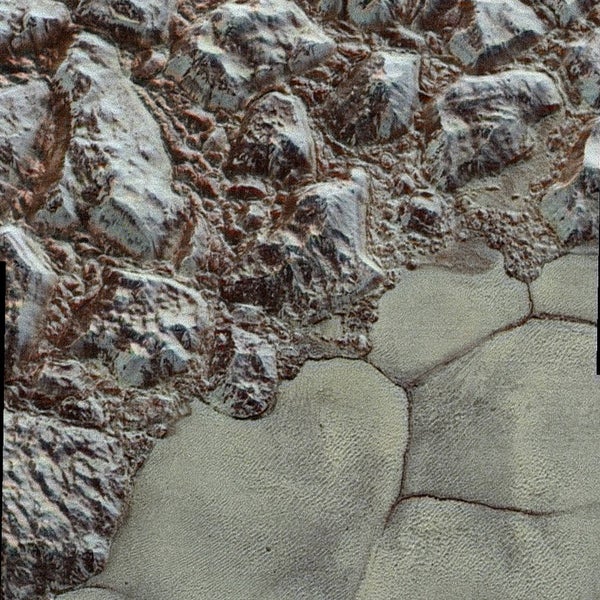This article was published in Scientific American’s former blog network and reflects the views of the author, not necessarily those of Scientific American
Back when I was a kid, I had no idea we'd ever be doing geology at the ends of the solar system. If I'd known then I could combine my love of astronomy with my passion for geology, I might even have abandoned my dreams of fiction writing and poured myself into a degree in the planetary sciences.
Now we have robots in space, doing actual geology on other worlds. We've seen what the rovers on Mars have been up to. Now we'll turn to distant Pluto, which recently got downgraded to dwarf planet status. But just because a world is small doesn't mean it can't have world-class geology, and the things we're finding on Pluto are truly phenomenal.
On supporting science journalism
If you're enjoying this article, consider supporting our award-winning journalism by subscribing. By purchasing a subscription you are helping to ensure the future of impactful stories about the discoveries and ideas shaping our world today.
Mission scientists believe these mysterious indentations may form through a combination of ice fracturing and evaporation. The scarcity of overlying impact craters in this area also leads scientists to conclude that these pits – typically hundreds of yards across and tens of yards deep – formed relatively recently. Their alignment provides clues about the ice flow and the exchange of nitrogen and other volatile materials between the surface and the atmosphere.
I'm intrigued! I want to know what geologic processes are acting on Pluto that resurface the planet and erase the impact craters in some regions. I want to know more about these pits, and the different kinds of ice that are basically rocks on this frigid, distant dwarf planet.I cannot wait for the papers to start coming out!
It's got mountains and plains and glaciers - so much like Earth, only so very different.
This is a breathtaking look at just a tiny fragment of the geology we'll get to explore on this tiny world. It's full of mountains and plains and glaciers and intriguing cracks, oh my!
The nitrogen ice glaciers on Pluto appear to carry an intriguing cargo: numerous, isolated hills that may be fragments of water ice from Pluto’s surrounding uplands. These hills individually measure one to several miles or kilometers across, according to images and data from NASA’s New Horizons mission.
The hills, which are in the vast ice plain informally named Sputnik Planum within Pluto’s ‘heart,’ are likely miniature versions of the larger, jumbled mountains on Sputnik Planum’s western border. They are yet another example of Pluto’s fascinating and abundant geological activity.
Water ice, being less dense than nitrogen ice, can float atop the nitrogen glaciers all the way down to the plain. Floating hills! How cool is that?
But so far, nothing is quite as cool as the ice volcanoes. Volcanoes! On Pluto!
We don't know for sure the two suspected volcanoes we've found actually are volcanoes, but they surely do look like they are:
Of course, broad mountains with central craters are found elsewhere in the Solar System, like Mauna Loa on planet Earth and Olympus Mons on Mars. In fact, New Horizons scientists announced the striking similarity of Pluto's Wright Mons, and nearby Piccard Mons, to large shield volcanoes strongly suggests the two could be giant cryovolcanoes that once erupted molten ice from the interior of the cold, distant world.
Molten ice! Sounds like an oxymoron, but at Pluto temperatures, water basically would be magma. I wonder if what erupted was a slush? It's going to be so awesome to find out. And just imagine if Pluto's cryovolcanoes are still active, and a future mission catches one erupting.
And, finally, our very first geologic map of Pluto:
We don't have enough information to do more but vaguely describe what we're seeing, but it's a start. Human geologists may never be able to get their rock hammers on Pluto's icy features, but I hope that in our lifetimes, a robot geologist is able to explore, sample, and analyze those intriguing features.
What we've seen so far is like that delightful combination of scents wafting from the kitchen as dinner cooks. We know it's going to be great, and it can't come soon enough. Pluto turns out to be one of the most intriguing wee worlds in our solar system. I can't wait to see what it serves up!





